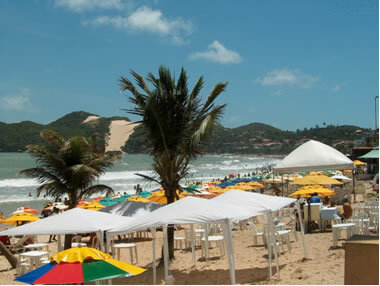Rio Grande do Norte is located in the Northeast region. Its territorial extension is 52,810,699 square kilometers, divided into 167 municipalities. According to the population count carried out in 2010 by the Brazilian Institute of Geography and Statistics (IBGE), the state has a total of 3,168,027 inhabitants.
The state's economic activities contribute as follows to the state's Gross Domestic Product (GDP): Agriculture (5.1%), Industry (24%) and Services (70.9%), highlighted as follows:
Agriculture is well diversified, focusing on the cultivation of rice, cotton, beans, tobacco, castor beans, sugar cane, papaya, melon, coconut, cassava, watermelon, mango, acerola, banana, cashew and corn. The development of techniques for the practice of irrigated fruit production provided a great increase in productivity, strengthening exports, especially to Europe.
Farming in the state of Rio Grande do Sul also represents a strong economic segment, represented by cattle and swine herds.
Industrial activity is concentrated in the metropolitan region of Natal, with emphasis on textile products, beverages, agribusiness and automobile industries. The oil industry is of fundamental importance for the economy of Rio Grande do Norte, since the The state is the largest national producer of oil on land, in addition to having three gas processing units Natural.

Coast of Rio Grande do Norte
With beautiful beaches, tourism is another important element in the state's economy. There are more than 2 million visitors annually, the main destinations being the beaches of Ponta Negra, Pipa and Genipabu. This activity is responsible for employing more than 120 thousand people, in addition to being linked to 54 other activities, directly or indirectly.
Mining stands out with the extraction of sea salt (about 90% of national production), limestone, tin, natural gas, oil and feldspar.
Another segment that deserves to be highlighted is the production of shrimp, which has presented a very evolutionary picture. Currently, the state is the largest Brazilian exporter of the crustacean.
Rio Grande do Norte export and import data:
Export – 347.5 million dollars.
Fresh fruit: 29%
Cashew Nuts: 13%
Crustaceans: 11%
Fuels and lubricants for ships and aircraft: 9%
Yarns, fabrics and garments: 7%
Sugars: 7%
Confectionery: 6%
Others: 18%
Imports - 207.3 million dollars
Plastic and its products: 17%
Wheat: 15%
Machines and equipment: 13%
Iron and steel tubes: 8%
Textile Machines: 7%
Generators: 7%
Cotton: 5%
Paper packaging: 4%
Others: 24%
The state's Gross Domestic Product (GDP) reached the mark of 22.9 billion reais, as the economy is in a constant process of development. However, its participation in the GDP of the Northeast is only 6.6% and at the national level, this mark reaches 0.9%.
By Wagner de Cerqueira and Francisco
Graduated in Geography
Brazil School Team
large northern river - Northeast region - geography of Brazil - Brazil School
Source: Brazil School - https://brasilescola.uol.com.br/brasil/economia-rio-grande-norte.htm
